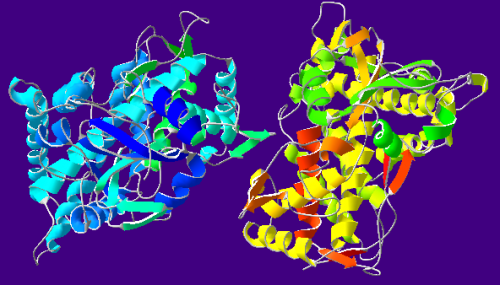Cytochrome P450 Oxidase (CYP2C9). Credit: Wikipedia/CC BY-SA 3.0
(Phys.org)—Cytochrome P450 (CYP) is sometimes referred to as the "Rosetta Stone" of iron-containing oxygenases, because of its ubiquity as a biocatalyst for various reactions, including drug metabolism and synthesis of biological molecules. Importantly, CYP catalyzes carbon-hydrogen hydroxylation reactions, cleaving some of the most difficult carbon-hydrogen bonding structures. While CYP is well studied, scientists are eager to understand the ferryl intermediates formed during hydroxylation in an effort to fine-tune catalytic reactions as well as seek out other biocatalysts to react with carbon-hydrogen bonds that are typically unreactive.
Researchers have recently found that aromatic peroxygenases (APO), a fungus-based heme thiolate protein, can catalyze the oxygenation of aliphatic and aromatic hydrocarbons. Based on the products from these reactions, APO seems to behave similarly to CYP, although it apparently is more stable over a larger range of pH. This provides an opportunity to study the hydroxylation reaction mechanism of an analogous molecule to CYP that could serve as another potential biocatalyst. Xiaoshi Wang and John T. Groves from the Department of Chemistry at Princeton University report the isolation and characterization of APO-II, an important intermediate in hydroxylation, in the Proceedings of the National Academy of Sciences.
Previous work by Groves' group has shown that APO, derived from Agrocybe aegerita forms an oxoiron (IV) porphyrin radical cation (APO-I) that can be detected by UV-visible spectroscopy. The current work, isolates APO-II, a reduced form of APO-I. APO has an OH2 group coordinated to the central iron atom. Oxidation, using mCPBA yields an oxidized, Fe=O, interaction. Wang and Groves sought to isolate APO-II, which has an OH group coordinated to iron, via a one electron reduction reaction.
Wang and Groves began by oxidizing APO using mCPBA, and then determined that the reduction of APO-I using a nitroxyl radical would provide APO-II. They tested their nitroxyl radical candidates using a model system, ensuring that they would get complete conversion from the oxidized to the reduced intermediate, and landed on 3-carboxy-PROXYL as the best reducing agent.
UV-visible spectroscopy confirmed that they made APO-II using a single-mixing stopped flow experiment. They were also able to confirm that APO-II was formed via the direct reduction of APO-I using a double-mixing step. Kinetic studies indicated that APO-II remained in solution for 0.5 seconds and has an approximate decay rate of 1 sec-1, making it an intermediate that is stable enough to allow for further study.
Because APO is stable at a wide range of pH values, pH 7.0 to pH 12, Wang and Groves were able to determine the pKa value of the proton on the hydroxyl group of APO-II using titration with buffer solutions and characterization with UV-visible spectroscopy. They found that the pKa for the hydroxyl proton was approximately 10, indicating that the molecule was protonated at a pH below 10. They also determined that the sulfur remained bound to the iron upon deprotonation at high pH.
Finally, Wang and Groves investigated the reactivity of various substrates in an APO-II catalyzed hydroxylation reaction. They found that APO-II has a surprisingly high reactivity toward phenols and substrates with relatively weak benzylic carbon-hydrogen bonds. The high reactivity with phenols was unexpected because analogous peroxidases typically do not react as quickly. Additionally, according to the kinetic data, APO-II seems to be a milder oxidant compared to APO-I, which was expected based on other systems.
This research provides insight into CYP-like reactivity by investigating a key intermediate in the hydroxylation reaction. According to Dr. Groves, "The surprisingly high reactivity of APO-II toward weak C-H bonds may facilitate the development of more selective biocatalysts."
More information: "Heme-thiolate ferryl of aromatic peroxygenase is basic and reactive" Xiaoshi Wang, Rene Ullrich, Marticn Hofrichter, and John T. Groves, www.pnas.org/cgi/doi/10.1073/pnas.1503340112
Abstract
A kinetic and spectroscopic characterization of the ferryl intermediate (APO-II) from APO, the heme-thiolate peroxygenase from Agrocybe aegerita, is described. APO-II was generated by reaction of the ferric enzyme with metachloroperoxybenzoic acid in the presence of nitroxyl radicals and detected with the use of rapid-mixing stopped-flow UV-visible (UV-vis) spectroscopy. The nitroxyl radicals served as selective reductants of APO-I, reacting only slowly with APO-II. APO-II displayed a split Soret UV-vis spectrum (370 nm and 428 nm) characteristic of thiolate ligation. Rapid-mixing, pH-jump spectrophotometry revealed a basic pKa of 10.0 for the FeIV−O−H of APO-II, indicating that APO-II is protonated under typical turnover conditions. Kinetic characterization showed that APO-II is unusually reactive toward a panel of benzylic C−H and phenolic substrates, with second-order rate constants for C−H and O−H bond scission in the range of 10–107 M−1⋅s−1. Our results demonstrate the important role of the axial cysteine ligand in increasing the proton affinity of the ferryl oxygen of APO intermediates, thus providing additional driving force for C−H and O−H bond scission.
Journal information: Proceedings of the National Academy of Sciences
© 2015 Phys.org






















